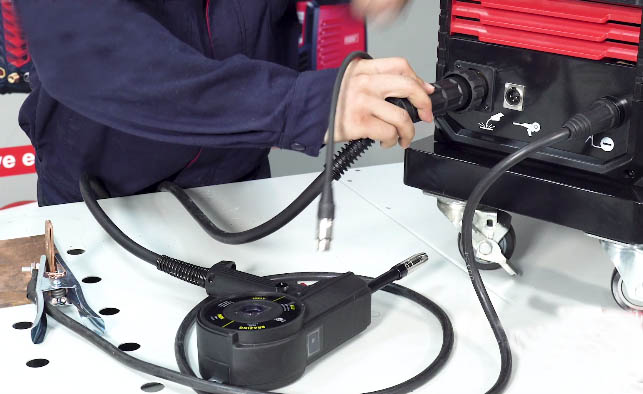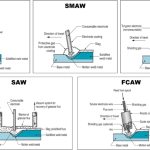Overcoming Warping and Distortion
Metal warping during the welding process can occur due to various reasons, but there are several effective ways to prevent this issue.
First and foremost, ensure that the metals you are welding are as closely positioned as possible, minimizing any gaps that would need to be filled. Additionally, if feasible, clamp the pieces of metal securely to a sturdy workbench to provide stability during the welding process.
If your MIG welder offers a pulse setting, it is worth trying out as well, as it can help mitigate the risk of metal warping.
MIG Welding Aluminum with a Spool Gun
Welding Town
Preventing Burn-through
Burn-through is a common occurrence when welding aluminum, despite its efficient heat transfer properties. The primary cause of burn-through is excessive heat. To address this issue, consider reducing the preheating of the metal. However, an even better approach is to slightly decrease the welder’s voltage or increase the travel speed as you run the bead.
By making these adjustments, you can effectively manage the heat input and minimize the risk of burn-through during the aluminum welding process.
Addressing Porosity Issues
Porosity is a common issue encountered when MIG welding aluminum, typically stemming from two main reasons.
Firstly, inadequate shielding gas can be a culprit. To address this, increase the cubic feet per hour (CFH) of the shielding gas and run another bead to see if the porosity improves.
Secondly, insufficient cleaning of the metal can introduce contaminants into the weld pool, leading to porosity. It is crucial to enhance the metal cleaning process to prevent this issue from occurring.
By addressing these factors, including optimizing the shielding gas and ensuring thorough metal cleaning, you can minimize the occurrence of porosity during MIG welding of aluminum.
Dealing with Black Soot Formation and Aluminum Oxidation
After completing a weld bead, it is not uncommon to observe a buildup of soot around the bead, often appearing as a brown or black smoke ring. However, it’s important to note that the immediate area surrounding the bead should remain clean and not resemble the appearance of a rusty, old piece of steel typically associated with stick welding.
Maintaining a clean and visually appealing weld zone is essential, and any excessive soot or discoloration should be addressed. Proper adjustments to the welding parameters, such as gas flow and shielding, as well as ensuring adequate metal cleaning, can help achieve a clean and visually pleasing weld bead.
Causes and Prevention
The primary cause of black soot and oxidation formation during welding is often related to the shielding gas used. To test this, increase the CFH (cubic feet per hour) on your regulator and observe the results.
In some cases, it may be necessary to raise the CFH to around 50 to achieve a proper weld bead. If increasing the CFH does not resolve the issue, it is likely that your gas contains Carbon Dioxide.
Unfortunately, gas tanks can become contaminated with Carbon Dioxide or other reactive gases, even when swapping tanks. Although it is relatively uncommon to refill tanks on the spot, this serves as an example of why tank swapping is generally preferred.
However, it’s important to note that even with a swapped tank, trace amounts of reactive gas may still be present, leading to welding problems.
Wire Storage and Handling Best Practices
Aluminum wire is prone to rapid deterioration due to oxidation, much like the bare metal itself. To prevent this, it is advisable to remove the wire from the welder and store it in a Ziplock bag.
This practice is particularly important if you don’t frequently weld aluminum. Impurities can quickly form on the wire, making it challenging to work with. Moreover, oxidation can contribute to the occurrence of porosity in the weld.
By storing the aluminum wire in a Ziplock bag, you can mitigate the effects of oxidation and ensure a smoother welding experience when using the wire again.
Importance of Contact Tips and Their Maintenance
Contact tips are not only crucial for feeding wire out of a MIG gun but also serve as the point where electricity is transferred into the wire during welding.
Given their significant role in MIG welding, it is essential to prioritize keeping the contact tips clean and fully functional.
Regularly inspecting and cleaning the contact tips will help ensure smooth wire feeding and maintain proper electrical conductivity during the welding process.
Preventing and Addressing Burnbacks
Dealing with burn back during MIG welding can be highly frustrating. However, there are simple steps you can take to prevent it.
One effective measure is to extend the stick out, ensuring that the distance between the contact tip and the workpiece is appropriately maintained. This adjustment can help reduce the likelihood of burn back.
Additionally, it is crucial to keep the nozzle of your MIG welder as clean as possible. Regular cleaning and maintenance of the nozzle will prevent any blockages or obstructions that may contribute to burn back issues.
Burnback can also occur if the wire feed rate is too slow or too fast to properly melt. Ensuring the correct wire feed rate is crucial for avoiding burn back problems.
By following these practices, you can minimize the occurrence of burn back and enjoy a smoother MIG welding experience.
Reusing Contact Tips and When to Replace Them
As previously mentioned, maintaining clean contact tips is crucial. However, if a glob of molten metal fuses between the contact tip and the nozzle, it is recommended to replace the tip. This ensures optimal performance and avoids any potential issues that may arise from a compromised contact tip.
Some welders even opt to use anti-spatter spray as an additional protective measure to prevent burn back and minimize damage to the contact tips.
By prioritizing tip cleanliness and taking the necessary steps to address any buildup or fusion, you can optimize the performance of your MIG welder and achieve better welding results.












